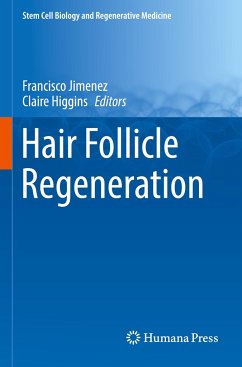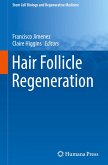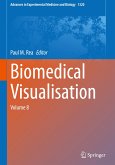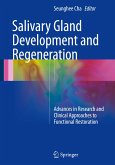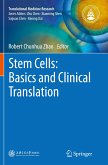This book aims to comprehensively review the current cell-based strategies under investigation to achieve the regeneration of human hair follicles. The unique capacity of the human hair follicle to self-renew explains why this complex "mini-organ" has always attracted so much interest as a model for researchers to study stem cell biology and regenerative medicine. The hair follicle is considered a main reservoir of cutaneous stem cells, containing several pools of epithelial, melanocyte, and mesenchymal stem cells involved in hair follicle self-regeneration and pigmentation. In addition, while some of the different follicular cell types contribute to hair shaft growth, others participate in very important interfollicular functions such as dermal remodeling, re-epithelialization after wounding, and cutaneous stem cell homeostasis.
The idea of human hair follicle regeneration either "de novo" or by activating dormant miniaturized follicles is not new, yet still continuesto arouse enormous interest in the pursuit of a definitive cure for baldness. In contrast to hair follicle regeneration in mice, the attempts made with human follicles have been disappointing in terms of efficiency. However, recent advances in stem cell biology-as well as the appearance of new technologies like 3D printing-have revived expectations in this field of research.
This book is divided into four sections. The first part includes an overview of the strategies used in hair follicle regeneration and a historical summary of the most important achievements to date. Parts two and three comprise the main body of the book, with detailed descriptions of the cells and tissue structures involved in hair follicle regeneration, followed by an elaboration of the different therapeutic strategies, engineering techniques, and a clinician's perspective of stem cell-based therapies in hair loss treatments. Finally, the fourth part reviews the important contribution of the hair follicle in healing cutaneous wounds through the regeneration and remodeling of the dermis and epidermis after injury, as well as wound induced hair follicle neogenesis that occurs when the skin is injured.
The idea of human hair follicle regeneration either "de novo" or by activating dormant miniaturized follicles is not new, yet still continuesto arouse enormous interest in the pursuit of a definitive cure for baldness. In contrast to hair follicle regeneration in mice, the attempts made with human follicles have been disappointing in terms of efficiency. However, recent advances in stem cell biology-as well as the appearance of new technologies like 3D printing-have revived expectations in this field of research.
This book is divided into four sections. The first part includes an overview of the strategies used in hair follicle regeneration and a historical summary of the most important achievements to date. Parts two and three comprise the main body of the book, with detailed descriptions of the cells and tissue structures involved in hair follicle regeneration, followed by an elaboration of the different therapeutic strategies, engineering techniques, and a clinician's perspective of stem cell-based therapies in hair loss treatments. Finally, the fourth part reviews the important contribution of the hair follicle in healing cutaneous wounds through the regeneration and remodeling of the dermis and epidermis after injury, as well as wound induced hair follicle neogenesis that occurs when the skin is injured.

